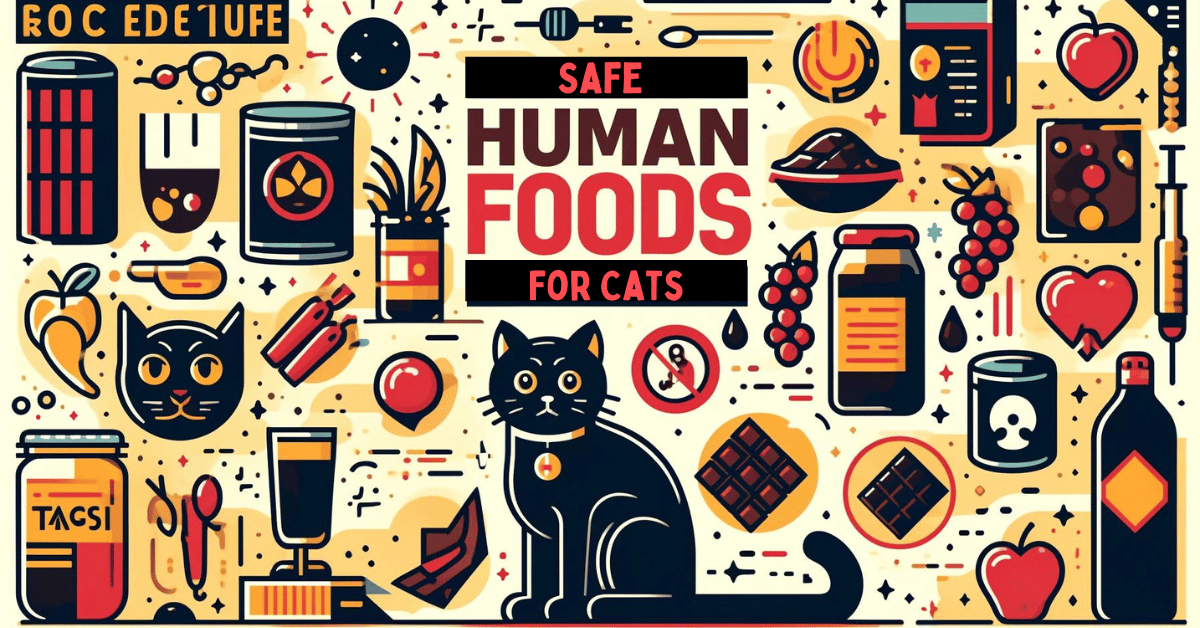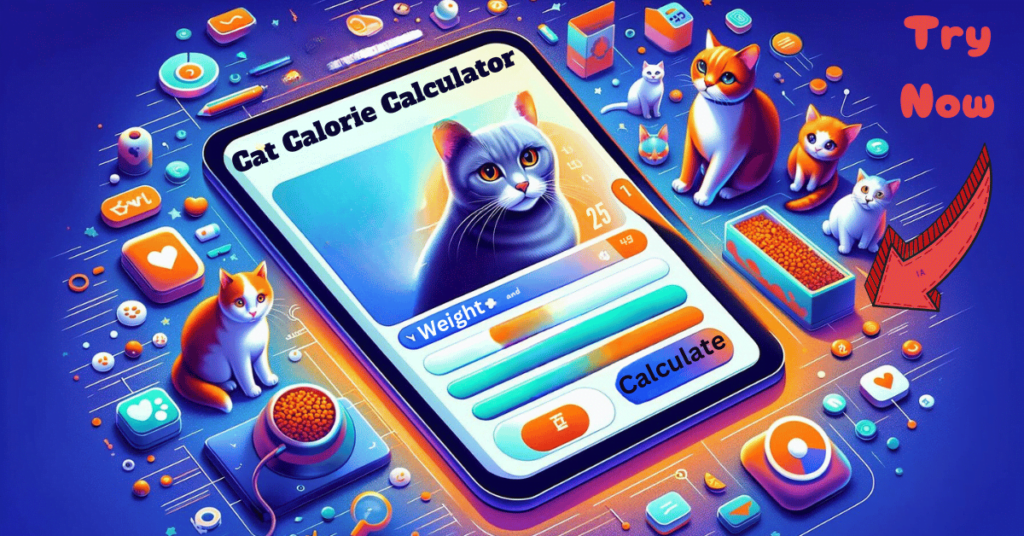This post contains affiliate links and I will be compensated if you make a purchase after clicking on my links.
Table for Two: Navigating What Human Foods Can Cats Eat
Have you ever caught your cat gazing longingly at your dinner plate, their eyes wide with curiosity (and maybe a hint of envy)? It’s a scene familiar to many cat owners, sparking the question: “Can I share a bite with my feline friend?” While we might be tempted to slide a piece of our meal their way, especially under the weight of those pleading stares, it’s crucial to remember that cats have sensitive stomachs.
Not all human foods are safe for our purring pals, and what seems like a harmless treat could lead to a furball of chaos.
Before you cave to those adorable, begging eyes, let’s arm ourselves with knowledge. It’s not just about what cats like to eat, but also what’s safe for them. So, even if Fluffy seems eager to dive into your dinner, it’s crucial to have this list at the ready to ensure their health and happiness.
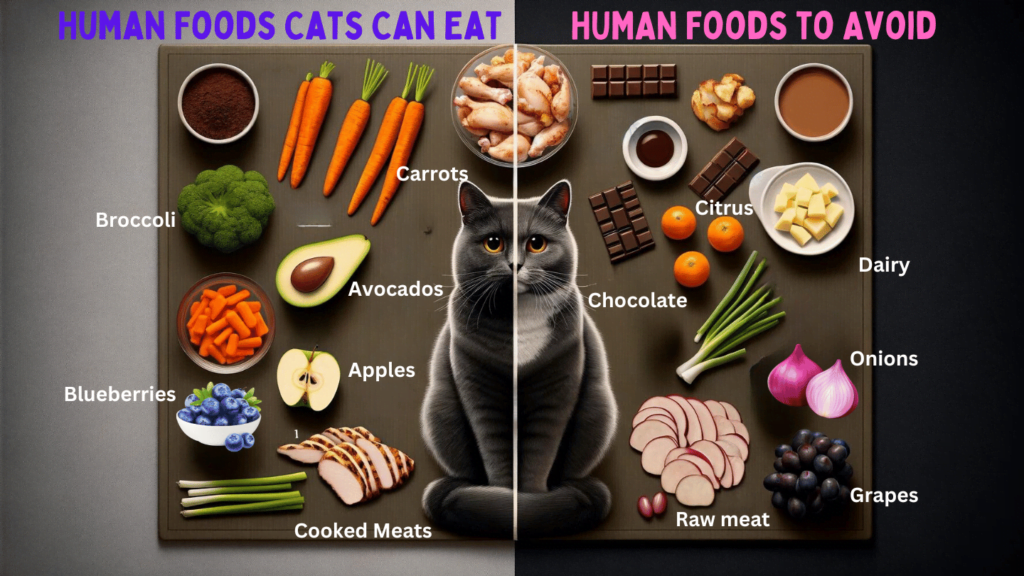
Human Foods Safe for Cats: Your Ultimate Guide
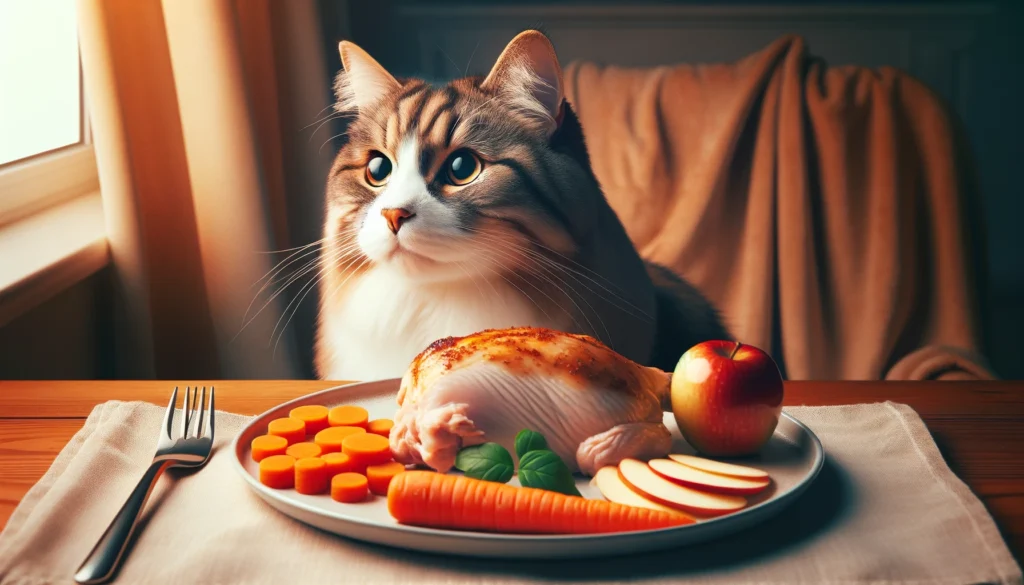
Proteins
1. Cooked Chicken: Generally Safe
Boneless and cooked without spices, chicken is a fantastic source of lean protein for cats, supporting healthy muscle function. Just ensure it’s thoroughly cooked to avoid any risk of bacterial infection.
2. Cooked Turkey: Generally Safe
Lean and unseasoned turkey offers similar benefits to chicken. It’s high in protein but should be offered in moderation to maintain a balanced diet.
3. Lean Beef: Generally Safe
Cooked, without any fat and seasonings, beef provides a rich source of protein and essential nutrients like iron. It’s a hearty option for cats in need of a protein boost.
4. Salmon: Moderation is Key
Cooked salmon should be offered in moderation due to potential mercury exposure but is excellent for omega-3 fatty acids, which support skin and coat health.
5. Tuna: Moderation is Key
Cooked or canned in water, not in oil, and without any added salt, tuna can be a tasty treat. However, its high mercury content means it should only be a sporadic delicacy.
6. Cooked Eggs: Generally Safe
Fully cooked eggs are safe and provide a high-quality protein source, plus essential vitamins and minerals. Raw eggs should be avoided to prevent the risk of salmonella.
Vegetables (Should be cooked and plain)
7. Carrots: Generally Safe
Can be a crunchy, sweet treat when cooked. They’re low in calories and high in fiber and vitamins, making them a healthy snack in moderation.
8. Peas: Generally Safe
Often found in commercial cat foods, peas are a good source of vitamins and minerals. They can be served cooked as a tasty and nutritious treat.
9. Broccoli: Generally Safe
Offer in small amounts; rich in fiber and nutrients, it supports digestive health and promotes regular bowel movements. Start with minimal portions to gauge your cat’s reaction.
10. Pumpkin: Highly Beneficial
Not the pie filling kind, plain cooked pumpkin can aid in digestion and is a great source of fiber. It can help with both constipation and diarrhea in cats.
11. Zucchini: Generally Safe
Safe in small amounts, zucchini is low in calories and can add variety to your cat’s diet without adding unnecessary sugar or calories.
12. Spinach: Caution Advised
Nutrient-rich, but avoid if your cat is prone to calcium oxalate bladder stones. Spinach can contribute to stone formation in susceptible cats.
Fruits (In moderation and ensure no seeds/pits)
13. Apples (without the seeds): Generally Safe
Apples (seeds removed) can be a healthy, hydrating snack packed with vitamins but always remove the core and seeds to avoid toxins.
14. Blueberries: Generally Safe
Blueberries are rich in antioxidants and can be a low-calorie treat. They’re great for boosting the immune system and overall health.
15. Melon: Generally Safe
Melon, including watermelon, cantaloupe, and honeydew, can be hydrating and is a source of vitamins A and C. Ensure it’s seedless and offered in moderation.
16. Avocado: Safe but with Caution
Avocados may get a cautious thumbs-up for your whiskered companion, albeit in tiny tastes. The flesh, served in petite portions, is generally safe for felines and offers a delightful variety.
Other Safe Treats
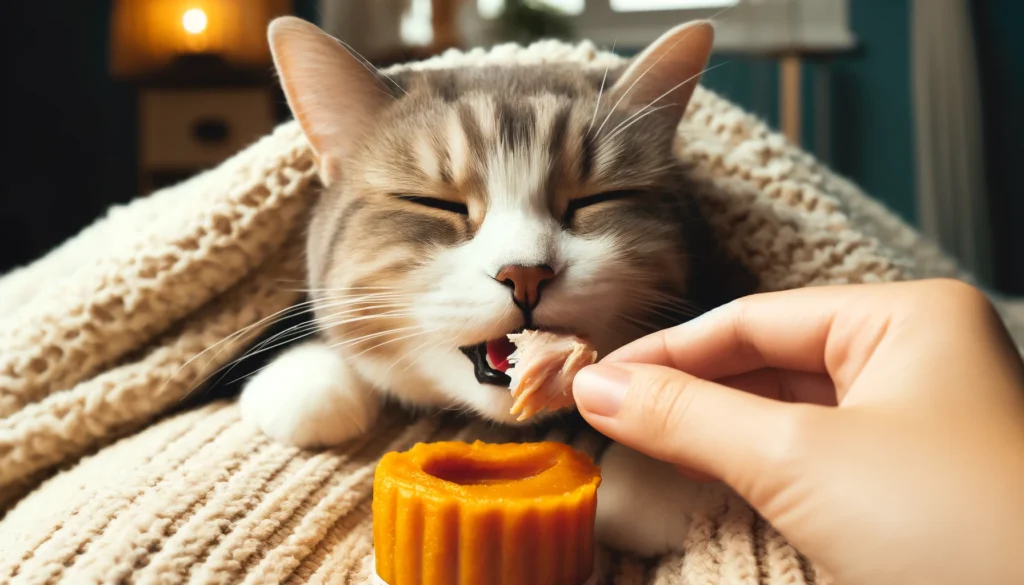
17. Rice and Pasta: Generally Safe
Plain and cooked, these can be a good source of carbohydrates. Ideal for cats needing a little extra energy, but keep portions small due to their caloric density.
18. Plain Popcorn: Generally Safe
Without butter or salt, a few pieces of plain popcorn can be a fun, low-calorie treat. Ensure it’s fully popped to avoid choking hazards.
19. Chicken or Beef Broth: Generally Safe
Unsalted and without onion or garlic, broths can enhance flavor and encourage hydration. They’re comforting and can be particularly beneficial for cats feeling under the weather.
20. Baby Food: Caution Advised
Meat-based, without garlic, onion, or preservatives, some baby foods can be a handy treat or medication vehicle, but always check the ingredients first.
The No-Fly List: Human Foods Cats Can’t Eat

As much as we love to share our meals with our furry companions, there’s a dark side to the pantry that we need to keep our cats away from. Let’s break down the no-go zones:
Toxic Troubles
- Onions and Garlic: Highly Toxic. These common kitchen staples can cause anemia in cats by breaking down red blood cells.
- Chocolate: Highly Toxic. Contains theobromine and caffeine, which are poisonous to cats and can lead to heart and nervous system issues.
- Caffeine: Highly Toxic. Found in coffee, tea, and some sodas, caffeine can be fatal, causing heart palpitations and severe agitation.
- Xylitol: Highly Toxic. This sweetener found in gum, candy, and some baked goods can cause liver failure and hypoglycemia.
- Alcohol: Highly Toxic. Even small amounts can cause severe liver and brain damage in cats.
- Grapes and Raisins: Highly Toxic. Even in small quantities, they can cause kidney failure in cats.
- Citrus: Mild to Moderately Toxic. Naturally repel cats with their strong scent, offering a protective instinct against the stomach distress and more serious health issues they can cause in larger quantities.
- Nuts: Varied Toxicity. Certain nuts, like macadamia nuts, are toxic to cats and can cause neurological symptoms.
- Salty Snacks: Risk of Sodium Ion Poisoning. Foods high in salt can cause excessive thirst, urination, and even sodium ion poisoning.
Digestive Distress
- Dairy Products: Caution Advised. Many cats are lactose intolerant, and consuming milk or dairy can lead to digestive upset.
- Raw/Undercooked Meat, Eggs, and Fish: Risk of Bacteria and Parasites. Raw foods can contain salmonella and E. coli, and raw fish can deplete essential nutrients, leading to deficiencies.
- Yeast Dough: Risk of Gas and Intestinal Blockage. Yeast dough can rise in your cat’s stomach, causing pain and potentially dangerous blockages.
Fatty Foods & Bones
- Fatty Foods: Risk of Pancreatitis. Foods high in fat can lead to pancreatitis, a painful and potentially dangerous condition.
- Bones: Choking Hazard. Cooked or raw bones can splinter and cause choking or serious digestive tract injuries.
Moderation and Monitoring
Understanding that not all human foods are off-limits, the key to a healthy diet for your cat is moderation and careful monitoring.
Portion Control
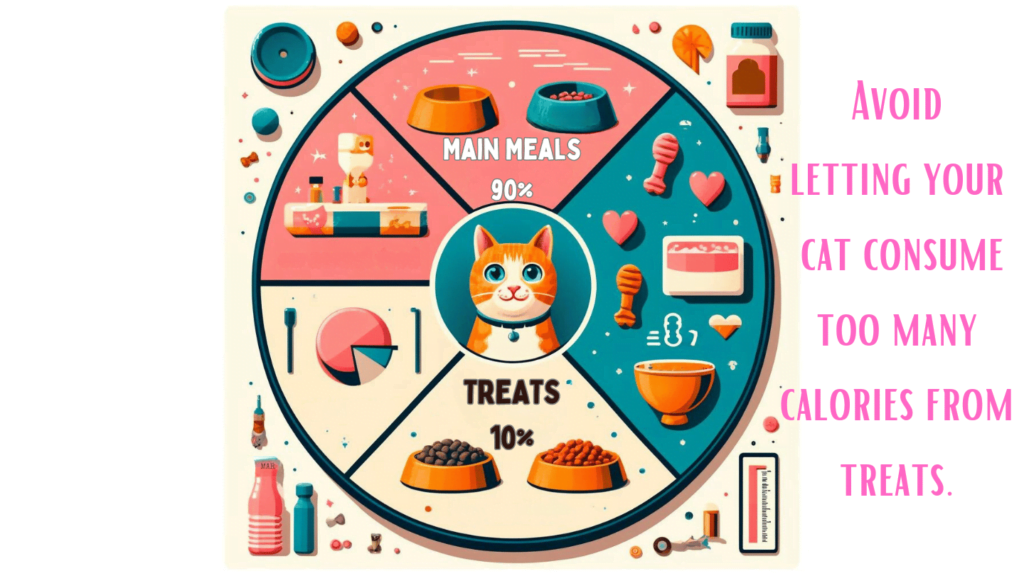
- Treats, Not Meals: Crucial Balance. Ensure human foods are occasional treats and do not exceed 10% of your cat’s total dietary intake to maintain a balanced diet.
Observation
- Monitor for Adverse Reactions: Essential. After introducing any new food, observe your cat for signs of digestive upset or allergic reactions, and always introduce new foods gradually.
By keeping these guidelines in mind, you can ensure that your shared meals and treats not only strengthen your bond but also keep your cat healthy and safe.
When in Doubt, Consult the Vet
Before turning your kitchen into a feline-friendly café, there’s one crucial step every pet parent should take: talk to your vet. Whether you’re considering introducing a new treat or overhauling Fluffy’s diet, your veterinarian is your go-to resource for advice that’s tailored to your cat’s specific health needs and nutritional requirements.
Creating a balanced diet plan that includes both cat food and the occasional human food treat requires a nuanced understanding of your cat’s health.
Last Licks: A Recap on What Human Foods Can Cats Eat
As we’ve navigated through the dos and don’ts of sharing your plate with your purring companion, remember: the joy of bonding over food transcends species. Including your cat in meal times with safe, appropriate human foods can add a delightful dimension to your relationship, making mealtimes a shared pleasure.
And when you find that purr-fect treat that makes your cat’s eyes light up (without upsetting their stomach), remember, you’ve just added another chapter to your shared story.
Meet Sean, a fintech whiz with a penchant for pet purrs and blockchain buzz. After a decade of fintech feats, Sean’s tech talents leaped from ledger lines to litter lines, driven by a passion for pets and a vision for a more connected pet care community. With three critter companions as co-pilots, Sean launched this blog to share a treasury of pet-friendly tech tips and tales.

